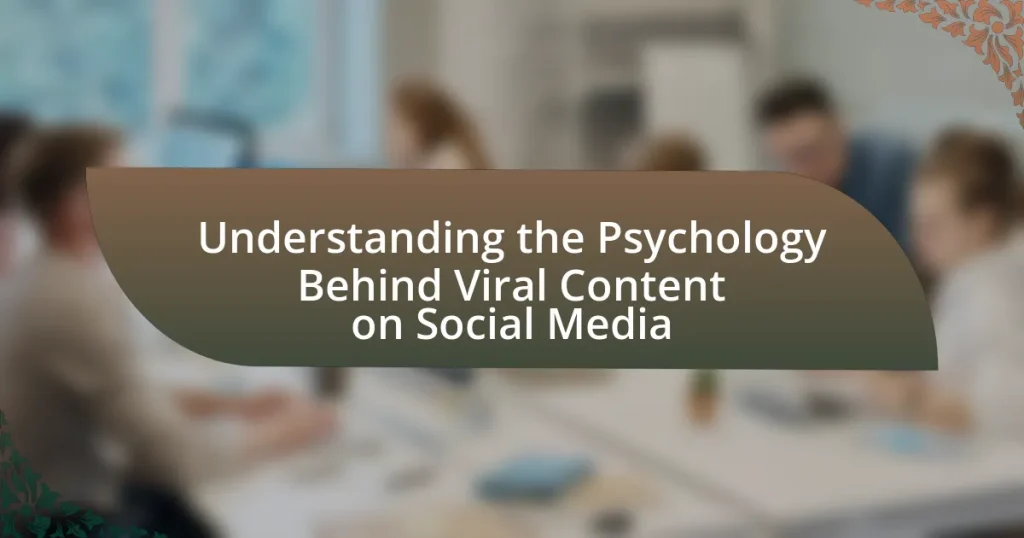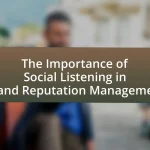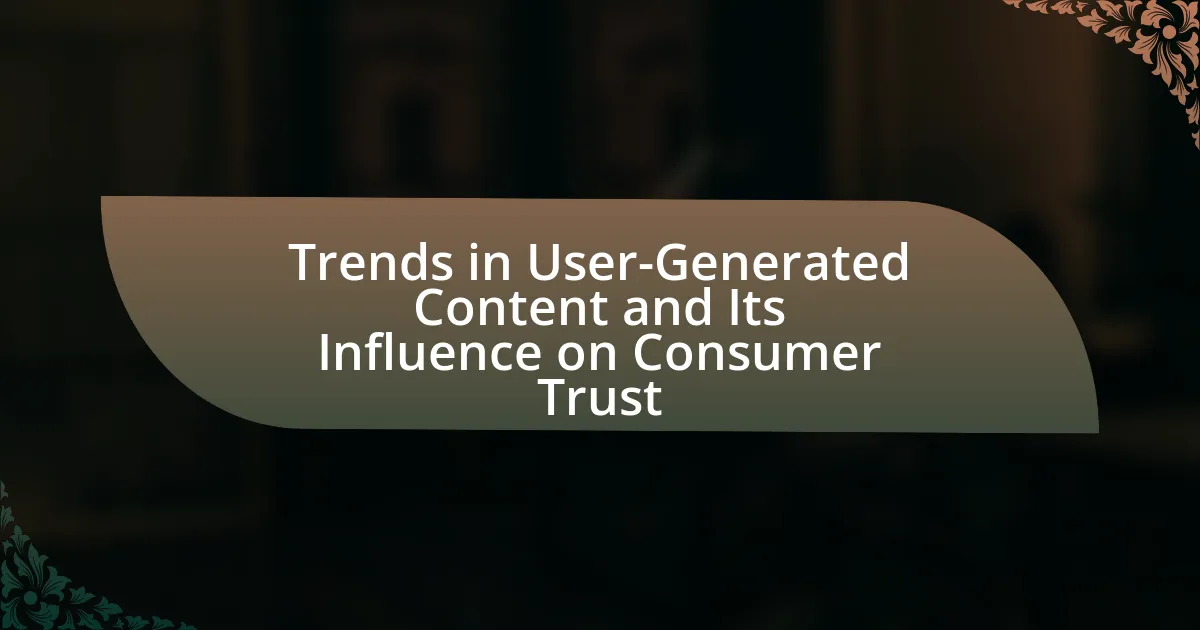The article explores the psychology behind viral content on social media, emphasizing the roles of emotional engagement, social validation, and cognitive biases in driving user sharing behavior. It highlights how emotionally charged content is more likely to be shared, supported by research indicating that high-arousal emotions lead to increased engagement. Additionally, the article discusses the impact of social proof, audience targeting, and storytelling techniques on content virality, while also identifying common pitfalls that can hinder a piece from going viral. Understanding these psychological factors can significantly enhance content creation strategies, ultimately leading to greater visibility and interaction on social media platforms.

What is the Psychology Behind Viral Content on Social Media?
The psychology behind viral content on social media is primarily driven by emotional engagement, social validation, and cognitive biases. Emotional engagement occurs when content elicits strong feelings such as joy, surprise, or anger, prompting users to share it with others. Research indicates that emotionally charged content is more likely to be shared; for example, a study published in the journal “Science” found that content evoking high-arousal emotions is shared more frequently than neutral content.
Social validation plays a crucial role as individuals often seek approval from their peers. When users see others sharing or liking content, they are more inclined to engage with it themselves, creating a snowball effect. This phenomenon is supported by the concept of social proof, where people look to the behavior of others to guide their own actions.
Cognitive biases, such as the bandwagon effect and the mere exposure effect, also contribute to the virality of content. The bandwagon effect suggests that individuals are more likely to adopt behaviors or beliefs if they see others doing the same, while the mere exposure effect indicates that repeated exposure to content increases its likability. These psychological factors collectively enhance the likelihood of content going viral on social media platforms.
How does psychology influence the sharing of content?
Psychology significantly influences the sharing of content by tapping into emotional triggers and social validation. When individuals encounter content that evokes strong emotions, such as joy, surprise, or anger, they are more likely to share it, as emotional arousal enhances engagement and memory retention. Research indicates that content that elicits positive emotions is shared more frequently; for instance, a study published in the journal “Science” found that emotionally charged articles are shared 30% more than neutral ones. Additionally, the desire for social approval drives sharing behavior, as individuals seek to present themselves positively to their peers. This phenomenon is supported by the concept of social proof, where people are influenced by the actions of others, leading to increased sharing of popular or trending content.
What psychological triggers encourage users to share content?
Psychological triggers that encourage users to share content include social validation, emotional resonance, and the desire for self-expression. Social validation occurs when users perceive that sharing content will enhance their social status or approval among peers. Emotional resonance, such as content that evokes joy, surprise, or anger, compels users to share their feelings with others. The desire for self-expression drives users to share content that reflects their identity or beliefs. Research by Berger and Milkman (2012) in “What Makes Online Content Viral?” published in the Journal of Marketing Research, indicates that emotionally charged content is more likely to be shared, supporting the significance of these psychological triggers.
How do emotions play a role in content virality?
Emotions significantly influence content virality by driving engagement and sharing behaviors among users. Content that evokes strong emotional responses, such as joy, anger, or surprise, is more likely to be shared, as individuals often seek to communicate their feelings with others. Research by Berger and Milkman (2012) in the study “What Makes Online Content Viral?” published in the Journal of Marketing Research found that emotionally charged content, particularly that which elicits high arousal emotions, is shared more frequently than neutral content. This correlation between emotional engagement and sharing behavior underscores the critical role emotions play in determining the virality of content on social media platforms.
Why do certain types of content go viral?
Certain types of content go viral due to their emotional resonance, relatability, and shareability. Content that evokes strong emotions, such as joy, surprise, or anger, tends to be shared more widely, as evidenced by a study from the New York Times, which found that articles that elicited high emotional responses were more likely to be shared. Additionally, content that is easily relatable to a broad audience encourages sharing, as individuals feel a connection to the material. Furthermore, shareable content often includes elements like humor, visual appeal, or unique perspectives, which enhance its likelihood of being disseminated across social media platforms.
What characteristics define viral content?
Viral content is characterized by its ability to evoke strong emotional responses, encourage sharing, and resonate with a wide audience. Content that triggers emotions such as joy, surprise, or anger tends to be shared more frequently, as evidenced by a study from the New York Times, which found that emotionally charged articles were more likely to be shared on social media platforms. Additionally, viral content often includes relatable themes or humor, making it accessible and engaging for diverse demographics. The combination of these elements creates a compelling narrative that motivates users to share, thereby amplifying its reach and impact.
How does audience targeting affect content virality?
Audience targeting significantly enhances content virality by ensuring that the content reaches individuals most likely to engage with it. When content is tailored to specific demographics, interests, and behaviors, it resonates more deeply with the intended audience, increasing the likelihood of shares and interactions. For instance, a study by the Pew Research Center found that targeted social media ads can increase engagement rates by up to 300% compared to non-targeted content. This targeted approach not only amplifies initial reach but also fosters organic sharing, as individuals are more inclined to share content that aligns with their preferences and social circles.
What role does social proof play in viral content?
Social proof significantly enhances the likelihood of content going viral by leveraging the influence of others’ behaviors and opinions. When individuals observe that a piece of content has been liked, shared, or commented on by many, they are more inclined to engage with it themselves, believing it to be valuable or entertaining. Research indicates that social proof can increase engagement rates; for instance, a study published in the Journal of Marketing Research found that social validation, such as user ratings and reviews, can lead to a 20% increase in consumer engagement with content. This demonstrates that social proof not only influences individual behavior but also amplifies the reach and impact of viral content on social media platforms.
How does the behavior of others influence sharing decisions?
The behavior of others significantly influences sharing decisions by creating social proof and shaping perceptions of value. When individuals observe others sharing content, they are more likely to perceive that content as valuable or worthy of attention, leading to increased likelihood of their own sharing. Research indicates that social validation, such as likes, comments, and shares, can enhance the perceived credibility and attractiveness of content, prompting users to engage with it. For instance, a study published in the journal “Computers in Human Behavior” found that users are more inclined to share posts that have already received a high level of engagement from their peers, demonstrating the impact of collective behavior on individual sharing choices.
What are the effects of likes and shares on user engagement?
Likes and shares significantly enhance user engagement by increasing visibility and fostering a sense of community. When users like or share content, it not only signals approval but also encourages others to interact, creating a ripple effect that amplifies reach. Research indicates that posts with higher like and share counts receive up to 50% more engagement compared to those with fewer interactions, as highlighted in a study by the Pew Research Center. This demonstrates that likes and shares serve as social proof, motivating additional users to engage with the content.
How can understanding this psychology improve content creation?
Understanding the psychology behind viral content can significantly enhance content creation by enabling creators to tailor their messages to resonate with audience emotions and behaviors. By leveraging psychological principles such as social proof, emotional triggers, and cognitive biases, content creators can design more engaging and shareable material. For instance, research indicates that content that evokes strong emotional responses is more likely to be shared; a study published in the Journal of Marketing Research found that emotionally charged content can increase sharing rates by up to 30%. This understanding allows creators to strategically craft their narratives, visuals, and calls to action, ultimately leading to higher engagement and virality.
What strategies can be employed to create viral content?
To create viral content, employ strategies such as leveraging emotional triggers, utilizing storytelling, and optimizing for shareability. Emotional triggers, like humor or awe, significantly increase engagement; for instance, content that evokes strong feelings is 2.5 times more likely to be shared. Storytelling captivates audiences, making them more likely to connect with and share the content, as narratives can enhance relatability and memorability. Additionally, optimizing for shareability involves creating visually appealing and easily digestible formats, such as infographics or short videos, which research shows can increase sharing rates by up to 300%.
How can storytelling enhance the shareability of content?
Storytelling enhances the shareability of content by creating emotional connections that resonate with audiences. When narratives are woven into content, they engage viewers on a deeper level, making the information more relatable and memorable. Research indicates that emotionally charged stories are 22 times more likely to be remembered than facts alone, which significantly increases the likelihood of sharing. Additionally, storytelling can simplify complex ideas, making them more accessible and appealing, thus encouraging users to share with their networks.
What techniques can be used to evoke emotional responses?
Techniques to evoke emotional responses include storytelling, visual imagery, and the use of relatable characters. Storytelling engages audiences by creating a narrative that resonates with their experiences, as evidenced by research showing that stories can increase empathy and emotional engagement (Green & Brock, 2000). Visual imagery enhances emotional impact by providing vivid representations that trigger feelings, supported by studies indicating that images can elicit stronger emotional reactions than text alone (Bradley & Lang, 2000). Additionally, relatable characters allow audiences to connect personally, fostering emotional investment, which is crucial for content to go viral on social media platforms.
What are the common pitfalls to avoid in viral content creation?
Common pitfalls to avoid in viral content creation include lack of audience understanding, poor quality visuals, and failure to engage emotionally. Understanding the target audience is crucial; content that does not resonate with viewers is less likely to be shared. High-quality visuals are essential, as studies show that posts with appealing images receive 94% more views than those without. Additionally, emotional engagement drives sharing; content that evokes strong feelings, whether humor, joy, or surprise, is more likely to go viral.
How can over-saturation affect content virality?
Over-saturation negatively impacts content virality by diminishing audience engagement and interest. When a particular type of content floods social media platforms, users become desensitized, leading to reduced shares and interactions. Research indicates that when users encounter excessive similar content, their likelihood of engaging with new posts decreases significantly, as seen in studies showing that viral content often relies on novelty and uniqueness to capture attention. For instance, a study published in the Journal of Marketing Research found that content that is perceived as repetitive or overly familiar is less likely to be shared, highlighting the importance of originality in achieving virality.
What mistakes lead to content failing to go viral?
Content fails to go viral primarily due to a lack of emotional resonance, poor targeting, and insufficient promotion. Emotional resonance is crucial; content that does not evoke strong feelings, such as joy, surprise, or anger, is less likely to be shared. For instance, a study by Jonah Berger and Katherine Milkman published in the Journal of Marketing Research found that emotionally charged content is more likely to be shared, indicating that emotional appeal is a key factor in virality.
Poor targeting occurs when content does not align with the interests or demographics of the intended audience. If the content does not speak to the specific preferences of a target group, engagement will be low. Research from the Content Marketing Institute highlights that understanding audience personas significantly increases the chances of content being shared.
Insufficient promotion also plays a critical role; even the best content can fail to gain traction without effective distribution strategies. According to a report by BuzzSumo, content that is actively promoted through social media channels and influencer partnerships sees a much higher engagement rate compared to content that relies solely on organic reach.
What practical tips can help in creating viral content?
To create viral content, focus on evoking strong emotions, utilizing compelling visuals, and encouraging audience engagement. Content that triggers emotions such as joy, surprise, or anger is more likely to be shared; studies show that emotionally charged content can increase sharing rates by up to 30%. Additionally, incorporating eye-catching images or videos can enhance the likelihood of virality, as posts with visuals receive 94% more views than those without. Finally, prompting users to engage through calls to action, such as asking questions or encouraging shares, can significantly boost interaction rates, leading to increased visibility and potential virality.




